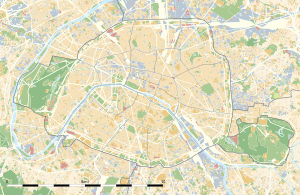Gare de la Bastille
Gare de la Bastille | |
|---|---|
| Heavy rail | |
 La Bastille Station in Paris, early 20th century | |
| General information | |
| Location | Place de la Bastille, Paris |
| Coordinates | 48°51′9″N 2°22′13″E / 48.85250°N 2.37028°E |
| Owned by | Chemins de fer de l'Est (1859–1938) SNCF (1938–1969) |
| Line(s) | Ligne de Vincennes |
| Tracks | 5 |
| History | |
| Opened | 22 September 1859 |
| Closed | 15 December 1969 |
The Gare de la Bastille was a railway station on the
History
Designed by

In 1871, following the end of the
Along with the

In the mid-1960s, construction of the
Services
When the station opened in 1859, services were provided by
Early passenger carriages were of a double-deck type known as "Imperials". From the 1890s, these were replaced by another double-deck type known as "Bidels". Trains usually included a
The Gare de la Bastille was, except possibly in its earliest days, an almost purely passenger station. Parcels and post were handled but almost the only freight was coal for the three-road engine shed. General freight was handled at a goods station located at the other end of the viaduct at Reuilly but the Gare de la Bastille did handle one rather unusual traffic. Following devastation by phylloxera and increased competition from wine shipped in by rail, vineyards that had traditionally supplied Paris in the area served by the outer rural section of the Ligne de Vincennes switched to growing roses. A Train des Roses was introduced as early as 1897, arriving at the Gare de la Bastille in the early hours. The roses were sold in the markets at Les Halles. Traffic peaked at over 1,000,000 roses per night.[3]
By the
References
- ^ a b "Attention le 14 décembre 1969 fermeture de cette gare…" (in French). AJECTA. Retrieved 8 April 2011.
- ^ "La gare Bastille – Vincennes – Paris 12e". Paris 1900. Retrieved 8 April 2011.
- ^ ISSN 0955-1298.
- ^ "141 TB 407: Une abonnée aux anniversaires…" (in French). AJECTA. Retrieved 8 April 2011.
- ISSN 0955-1298.
Further reading
- Leroy, Didier (2006). Paris – la Ligne de Vincennes: Inoubliables panaches (in French). Paris: La Vie du Rail. ISBN 2-915034-60-5.
- Giraud, Gérard; Mérille, Michel (2004). La Ligne de M. Gargan (in French). Les Pavillons-sous-Bois: Amarco. ISBN 2-9509571-8-8.
- Prévot, Aurélien (October 2009). "La ligne de Vincennes restée fidèle à la vapeur jusqu'à la mort ! Il y a 40 ans, la fin des 1.141 TB de la Bastille". Ferrovissime (in French) (20). Le Sablen: LR Presse: 2–21. ISSN 1961-5035.
External links
- SNCF Archive film of the Gare de la Bastille (in French)

